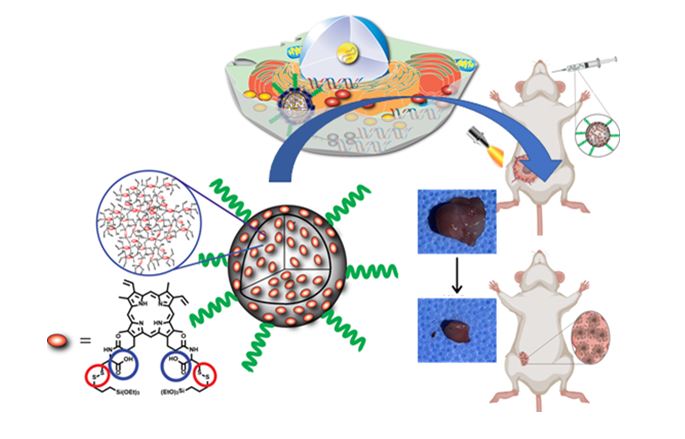Video Article Open Access
Multifunctional Polysilsesquioxane Nanoparticles for Combinatorial Therapy of Cancer
Juan L. Vivero-Escoto1*, Zachary K. Lyles1,2, Mubin Tarannum1,2, Ridhima Juneja1, Hemapriyadarshini Vadarevu1
1Department of Chemistry, University of North Carolina at Charlotte, Charlotte, 28223, USA
2Nanoscale Science Program, University of North Carolina at Charlotte, Charlotte, 28223, USA
Vid. Proc. Adv. Mater., Volume 1, Article ID 2020-0829 (2020)
DOI: 10.5185/vpoam.2020.0829
Publication Date (Web): 02 Nov 2020
Copyright © IAAM
Graphical Abstract

Abstract
Multifunctional hybrid nanoparticles are being developed to carry a wide variety of therapeutic and imaging agents for multiple biomedical applications. Polysilsesquioxane (PSilQ) nanoparticles is a promising hybrid platform with numerous advantages to be used as delivery system for combinatorial therapy. In this work, we developed a redox-responsive PSilQ-based platform to transport and deliver simultaneously protoporphyrin IX (PpIX) and curcumin inside human cells. These PSilQ nanoparticles contains a high loading of PpIX (24.4 ± 2.5 %wt) and curcumin (7.6 ± 1.5 %wt), and are biodegraded inside cancer cells due to the high reducing environment. This multimodal delivery system shows a synergistic performance for the combined photo- and chemotherapy of the triple-negative breast cancer (TNBC) MDA-MB-231 cells [1]. In addition, the safety and phototherapeutic efficacy of the PSilQ-based platform containing PpIX was evaluated in an orthotopic mice model of TNBC. The PSilQ nanoparticles are completely biodegraded and excreted from mice without any side effect. The efficacy data show that the PSilQ nanoparticles efficiently reduce tumor growth in the orthotopic mice model of TNBC [2]. This work demonstrates that PSilQ nanoparticle-based platform is an excellent alternative for the combined photo- and chemotherapy of TNBC.
Keywords
Polysilsesquioxane nanoparticles, combination therapy, photodynamic therapy, triple-negative breast cancer.
Acknowledgement
The authors acknowledge funding from the National Science Foundation (EAGER-NSF #1835688), SPRINT UNCC-FAPESP award, Faculty Research Grant award (FRG/UNC Charlotte), and the Department of Chemistry, UNC Charlotte start-up funds.
References
- R. Juneja, Z. Lyles, H. Vadarevu, K. Afonin, J.L. Vivero-Escoto, ACS Appl. Mater. Interfaces, 2019, 11, 12308.
- Z. Lyles, M. Tarannum, C. Mena, N.M. Inada, V.S. Bagnato, J.L. Vivero-Escoto, Advanced Therapeutics, 2020, https://onlinelibrary.wiley.com/doi/10.1002/adtp.202000022.
Biography
Juan L. Vivero-Escoto started his independent career in 2012 and he is currently an Associate Professor of the Chemistry Department at the University of North Carolina Charlotte (2018-present). He received his B.S. and M.S. in Chemical Engineering from the National Polytechnic Institute of Mexico (2004) and a Ph.D. in Chemistry from Iowa State University (2009). He was a postdoctoral fellow through the Carolina Postdoctoral program for Faculty Diversity at UNC Chapel Hill from 2010-2012. Dr. Vivero-Escoto has numerous professional honors including the Ralph E. Powe Junior Faculty Enhancement Award from Oak Ridge Associate Universities (ORAU) (2013), the Wells Fargo Faculty Excellence Award (2013), the CLAS Junior Faculty Development award UNCC (2015), Outstanding Faculty Award UNCC (2016), NSF Catalyst fellow (2017) and NSF AGEP-NC fellow (2019). His research focuses on the development of hybrid silica-based nanoparticles for biomedical applications. Dr. Vivero-Escoto has published over 50 peer-reviewed research papers, reviews, book chapters and editorials.
Video Proceedings of Advanced Materials

Upcoming Congress



